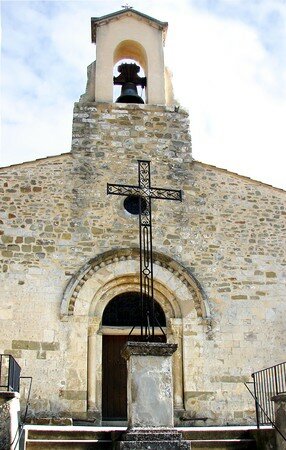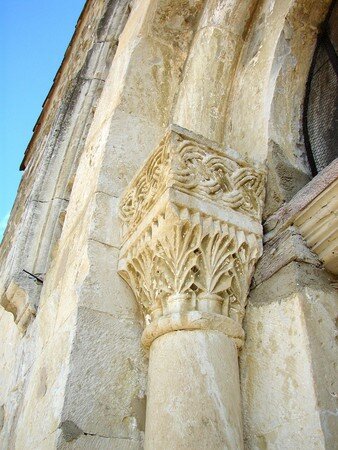Saint-Pierre of Vesc
 “Vaiesch”
in 1113, “Vaiesco” in 1409 (of Latin “episcopatum” which gave as old
French “evesquet”), Vesc is an old stronghold of the bishops of Die.
“Vaiesch”
in 1113, “Vaiesco” in 1409 (of Latin “episcopatum” which gave as old
French “evesquet”), Vesc is an old stronghold of the bishops of Die.
The Saint-Pierre church is that of a concerning priory abbey of Cruas in Vivarais. Romance building, it remains only the nave and the Western frontage: a nave of three spans, letting appear, outside, in the southernmost frontage, wrenchings of the buttresses and the two bays in semicircular arch, sealed today, which lit the second and third spans, the first, longer, remaining blind.
 This
same Southern wall well also shows that the construction of the
building developed at the same time Is in West but also, by stages,
upwards: indeed, whereas the average limestone apparatus faces the low
part of all the nave and the totality of the rise in the third span,
the high parts of the first two spans are assembled - because of a stop
of the building site, of a change of company or a provisioning near a
new career - in a russet-red sandstone good different from material
used for the remainder of the monument.
This
same Southern wall well also shows that the construction of the
building developed at the same time Is in West but also, by stages,
upwards: indeed, whereas the average limestone apparatus faces the low
part of all the nave and the totality of the rise in the third span,
the high parts of the first two spans are assembled - because of a stop
of the building site, of a change of company or a provisioning near a
new career - in a russet-red sandstone good different from material
used for the remainder of the monument.
 The Western frontage is the most remarkable part of the building, with
its gate in semicircular arch made of two curves separated by a torus
falling down on two posts with decorative capitals, with the reasons
archaïsants, the archivolt being decorated with teeth of gears and a
mouluration which diminishes on two consoles, that with right-hand side
presenting a couple with human heads (givers?). One of the trenchers
is decorated interlacing and the basket of the capitals covered with
stylized foliages, weak relief but carefully engraved, with the arrises
and, so hanging the light well: of not to doubt they are sculptures
there leaving the workshop to which one owes the decoration of the
platform of Cruas (Vivarais).
The Western frontage is the most remarkable part of the building, with
its gate in semicircular arch made of two curves separated by a torus
falling down on two posts with decorative capitals, with the reasons
archaïsants, the archivolt being decorated with teeth of gears and a
mouluration which diminishes on two consoles, that with right-hand side
presenting a couple with human heads (givers?). One of the trenchers
is decorated interlacing and the basket of the capitals covered with
stylized foliages, weak relief but carefully engraved, with the arrises
and, so hanging the light well: of not to doubt they are sculptures
there leaving the workshop to which one owes the decoration of the
platform of Cruas (Vivarais).
 One
will observe finally, here and there, in the frontages, of many Romance
re-employments: fragments of decorative reliefs in the Southern wall,
of the decorative sizes and the marks of drudges (A) in the Western
frontage and, in the Northern wall, whose facing was re-installed, of
the numbered archstones (I, III) and of the marks of drudges: BA, G,
NR, R, W. All these characteristics make it possible to locate the
construction of this priory particularly attaching about the middle of
XIIème century.
One
will observe finally, here and there, in the frontages, of many Romance
re-employments: fragments of decorative reliefs in the Southern wall,
of the decorative sizes and the marks of drudges (A) in the Western
frontage and, in the Northern wall, whose facing was re-installed, of
the numbered archstones (I, III) and of the marks of drudges: BA, G,
NR, R, W. All these characteristics make it possible to locate the
construction of this priory particularly attaching about the middle of
XIIème century.

/https%3A%2F%2Fprofilepics.canalblog.com%2Fprofilepics%2F1%2F1%2F116167.jpg)
/https%3A%2F%2Fstorage.canalblog.com%2F49%2F16%2F312499%2F14620054_o.jpg)
/https%3A%2F%2Fstorage.canalblog.com%2F53%2F18%2F312499%2F14151229_o.jpg)
/https%3A%2F%2Fstorage.canalblog.com%2F07%2F05%2F312499%2F14149867_o.jpg)
/https%3A%2F%2Fstorage.canalblog.com%2F11%2F35%2F312499%2F14149307_o.jpg)
/https%3A%2F%2Fstorage.canalblog.com%2F90%2F14%2F312499%2F14125247_o.jpg)



/https%3A%2F%2Fstorage.canalblog.com%2F12%2F98%2F137895%2F6624411_p.jpg)
/https%3A%2F%2Fstorage.canalblog.com%2F34%2F82%2F137895%2F27207854_p.jpg)
/https%3A%2F%2Fstorage.canalblog.com%2F32%2F37%2F137895%2F15872299_p.jpg)
/https%3A%2F%2Fstorage.canalblog.com%2F37%2F81%2F137895%2F15879822_p.jpg)